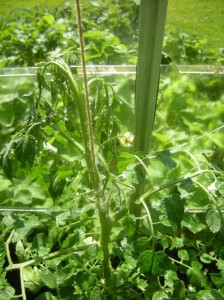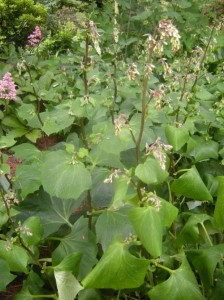High temperatures and intense sun have consequences. This is often seen in early afternoon where direct bright sun has shone on unprotected leafy material. Superficial wilt occurs which can be disturbing to see. No need to worry; with the coolness of the evening comes recovery.
At this time of day the transpiration rate slows and allows the plant to uptake water via the roots from the soil to replenish that lost in the heat of the day. Recovery is gentle and very rarely needs the use of a hose. The image shows Kirengeshoma palmata in mid afternoon exhibiting sun wilt. The following morning turgidity had returned to the plant.
By incorporating bulky organic matter into the soil during autumn and winter the humus content will increase. This in turn improves the moisture holding capacity of the soil and the soil biology increases.
The attached image shows the effect of lack of ventilation in a glasshouse on a growing tomato crop. The effect of the sun is intensified through the glass. Shading to the south or west elevations will be beneficial.
Save valuable water for food crops and where possible install a rain water collection system or use washing up or bath water to maintain moisture levels in the soil.
If you do use mains water direct it to the plants most in need through a micro bore drip system or a watering can. Avoid sprinklers or hoses as much water is wasted through these.


